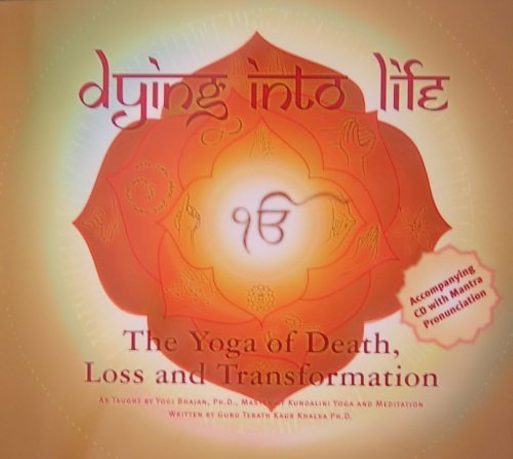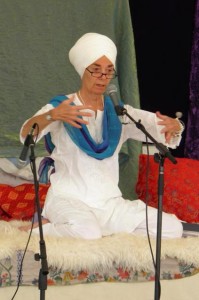 Dying Into Life: The Yoga of Death, Loss and Transformation by Jivan Joti Kaur Khalsa Ph.D is a thorough, highly logical and experience-based compendium of ideas and practices to aid anyone of any faith, culture, physical ability and age in navigating the transformational process of dying and grieving. It encourages readers to develop a relationship with their inner nature or True Self, and from that place, to cultivate a relationship with the material world through their ephemeral, ever-changing and temporary body. These teachings are expertly culled from the wisdom of Yogi Bhajan, who brought Kundalini Yoga to the Western world in 1968. In his own words, he came “to create teachers, not to gain students.” It is with this ethos of personal responsibility and empowerment that Dying Into Life was created.
Dying Into Life: The Yoga of Death, Loss and Transformation by Jivan Joti Kaur Khalsa Ph.D is a thorough, highly logical and experience-based compendium of ideas and practices to aid anyone of any faith, culture, physical ability and age in navigating the transformational process of dying and grieving. It encourages readers to develop a relationship with their inner nature or True Self, and from that place, to cultivate a relationship with the material world through their ephemeral, ever-changing and temporary body. These teachings are expertly culled from the wisdom of Yogi Bhajan, who brought Kundalini Yoga to the Western world in 1968. In his own words, he came “to create teachers, not to gain students.” It is with this ethos of personal responsibility and empowerment that Dying Into Life was created.
Despite a growing openness to alternative (re: non-Christian) spiritualities in mainstream North American culture, Kundalini Yoga can seem at first to carry the seductive danger of blind faith inherent in many new-age cults and self-help initiatives. That is not the case, however, with the teachings of Yogi Bhajan, nor does it resonate with the offering of Dying Into Life. Instead of 12 steps to heal your life, or a spiritual band-aid for feelings of groundlessness, Khalsa lays out the basic philosophy of Kundalini Yoga: helpful perspectives and anecdotes on the dying and grieving process, and simple, widely-adaptable practices to connect to one’s own truth and recognize it as universal truth. This may seem like a lofty initiative, but Khalsa always grounds the information in the tangible world through practical application and personal reflection.
Dying Into Life opens with Khalsa’s own story of experiencing the death of Yogi Bhajan as one of his students; this theme resonates throughout the book. In Parts I-II, Khalsa lays the philosophical groundwork for the language she uses, such as the particularly Kundalini/Sikh understanding of terms like “God,” “spirituality” and “religion.” One of the first concepts is that of immanence: that Consciousness or God is indwelling everywhere in the universe, and that the material world is a tangible articulation of that consciousness, including the human form. She goes on to relate how the concepts of Karma, Dharma and Reincarnation are interrelated within the scope of daily wellness, decision-making and yogic science (which has been corroborated on many accounts by Western science).
If you understand on a non-linguistic, experiential level of what is being communicated through Khalsa’s words, you are at a good time in your life to continue seeking the self-control and actualization tools of Kundalini Yoga.
Khalsa’s skillful writing leaves lots of room for readers to incorporate their own existing concept of God/consciousness/higher power into the foundational concepts of the first half of the text, which includes practices that readers can do to integrate them on a cellular, felt-sense level. If you understand on a non-linguistic, experiential level of what is being communicated through Khalsa’s words, you are at a good time in your life to continue seeking the self-control and actualization tools of Kundalini Yoga.
In the second half of Dying Into Life, Khalsa covers topics such as “Rehearsing Death,” “Children and Death” and “Healing Through Grief.” Included within each topic are visualizations, meditations and yoga sets/kriyas to give the reader a direct experience of the concepts as well as help to cultivate a disposition that is healthy, sane, and functional regarding attitudes toward loss: mortality of self and others, community in grief and fear of the unknown.
If you are able to recognize Dying Into Life as a project driven by a genuine, non-attached and service-oriented desire to see North Americans cultivate a more balanced perspective on their place in the cycle of life, then this book is definitely for you.
If you are able to recognize Dying Into Life as a project driven by a genuine, non-attached and service-oriented desire to see North Americans cultivate a more balanced perspective on their place in the cycle of life, then this book is definitely for you. Because its ideas are couched in spiritual language that may be initially alienating for some readers, do your best to understand the core of what is being shared, and seek out the advice of a local Kundalini teacher and/or open-minded counseling professional to help you put the especially big concepts into your own words.

 Dying Into Life: The Yoga of Death, Loss and Transformation by Jivan Joti Kaur Khalsa, Ph.D
Dying Into Life: The Yoga of Death, Loss and Transformation by Jivan Joti Kaur Khalsa, Ph.D



 John Mulaney’s “Funeral Planning” on Netflix: No Real Plan
John Mulaney’s “Funeral Planning” on Netflix: No Real Plan

 Composting Bodies Is Now Legal in a Dozen States
Composting Bodies Is Now Legal in a Dozen States














